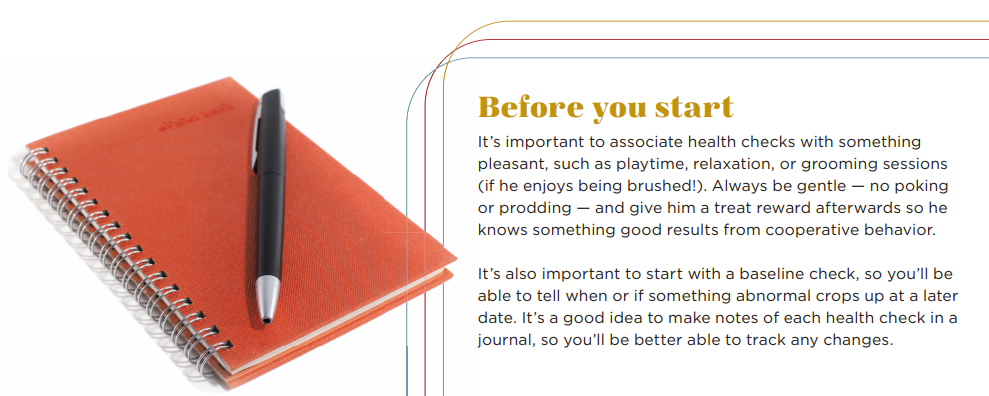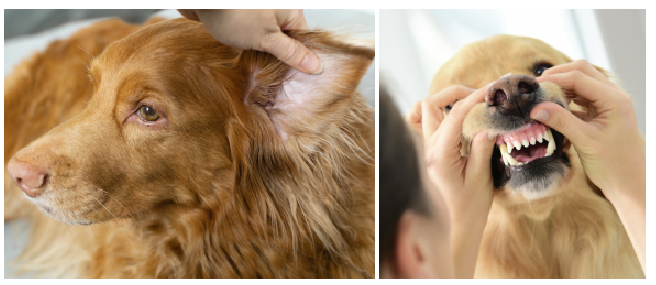A home health check for your dog or cat

Doing a regular head-to-tail health check on your dog or cat is a good way to keep on top of any changes in his well-being that might require veterinary attention.
Dogs and cats are pros when it comes to hiding pain. It’s an ancestral trait that was used for self-protection in the wild. These days, the “wild” might only be the dog park or backyard, but the trait persists. If your dog or cat isn’t acting sick, it’s easy to assume all is fine, which means you might remain unaware of any changes in your four-legged friend’s wellness. Home health checks can help you detect problems before they get too bad, or even before more obvious signs manifest. Follow this head-to-tail checklist, and be sure to contact your veterinarian if you notice anything out of the ordinary.

Start your health check with the eyes, ears and nose
- Eyes: Your dog or cat’s eyes should be clear, with no cloudiness or color change. Red flags include mucus, watery or bloodshot eyes, or any bulging or swelling. Dangle a toy to test his response to movement.
“To check a dog’s sight, I cover one of his eyes with my hand and move an object into the line of vision to check the other eye,” says Rebecca Sanchez, an animal lifestyle expert and senior dog adopter.
 Ears: “Remove dirt and earwax with a soft cloth moistened with a pet-specific solution,” says Denise Fleck, a pet safety expert and animal care instructor. “Alcohol’s drying and can sting. Vinegar doesn’t have the correct pH. Chamomile or green tea, with antibacterial/antifungal properties, can calm inflammation. Don’t flush the ear — it washes everything into the canal and onto the eardrum [If you notice] redness, a foul odor, or what looks like coffee grounds…get the cat or dog to the vet. These could mean a yeast or fungal infection, or ear mites, and those require treatment.”
Ears: “Remove dirt and earwax with a soft cloth moistened with a pet-specific solution,” says Denise Fleck, a pet safety expert and animal care instructor. “Alcohol’s drying and can sting. Vinegar doesn’t have the correct pH. Chamomile or green tea, with antibacterial/antifungal properties, can calm inflammation. Don’t flush the ear — it washes everything into the canal and onto the eardrum [If you notice] redness, a foul odor, or what looks like coffee grounds…get the cat or dog to the vet. These could mean a yeast or fungal infection, or ear mites, and those require treatment.”
Test your dog or cat’s hearing by having a helper make a noise while you observe the reaction.
- Nose: A runny nose, crustiness, sneezing, or mucus bubbles are all signs of a problem. Noses shouldn’t be dry or excessively wet. Breathing should be clear, not struggling, or raspy.
Take a look in his mouth
- Teeth: Dental health can affect your animal’s entire well-being, so don’t gloss over this part. Look for tartar buildup, and broken, loose, or worn teeth. A change in appetite, or turning away from petting or touching, could mean a painful tooth or a foreign object is the problem.
- Gums: Your animal’s gums should be a healthy pink (with the exception of dog breeds like Chow Chows, which have naturally-pigmented black gums). Any changes from normal, such as much paler or redder gums, or white spots on normally black gums, can be signs of a serious problem and call for veterinary care.
- Breath: Dog and cat breath shouldn’t make you recoil. Bad breath is a sign of dental problems.
- Tongue: His tongue should be pink, without a white coating. (As with gums, Chow Chows and other breeds can have black or black-spotted tongues.) Any sores or other abnormalities on the tongue necessitate a call to the vet.

Check over his skin and coat
- A dry brittle coat or hair loss can signal a dietary deficiency or other underlying problem.
- Red, itchy, inflamed skin also needs to be taken care of, along with sores that don’t heal, dryness, flakiness or smelliness, or pigment changes.
- Wrinkly dogs (e.g. pugs and bulldogs) and cats (e.g. Sphinx or Rex breeds) need to have their skin folds regularly checked for problems – these areas are moist and dark and can be a breeding ground for bacteria.
- An oily matted coat in a cat can mean she’s having trouble grooming herself.
Look for lumps and bumps
Give your dog or cat a head-to-tail petting massage to check for any abnormal lumps and bumps anywhere on his body. Older animals often develop fatty lumps, but it’s still a good idea to have these anomalies looked at by the vet, especially if they’re growing or bleeding.
Examine his feet and nails
- Nails that are too long are uncomfortable for him. Check nail length by gently pressing on the paw. If your dog or cat doesn’t let you trim her nails, or you’re not confident enough to do it yourself, have it done by the vet or a groomer.
- Canine and feline paw pads should be supple and not so dry that they’re cracked or split.
Time for the tail end
“Poop is the communicator of everything that’s going on inside the body,” says Rebecca. “Look for changes in color, smoothness or smell, and signs of blood, mucus, and any foreign objects, including worms. It’s gross but it’s part of loving our companions.” Frequent constipation and diarrhea also need to be checked by a vet.
Keep an eye on your dog or cat’s urinary habits as well. Has there been a change in how often your dog needs to go out? Is his urine voluminous or scanty? Is he straining to pee? Is there blood in the urine?
Scooping your cat’s litter box provides a daily update on her urinary status. Changes in urine output are a red flag. Straining or an inability to urinate is a veterinary emergency and needs immediate attention.
Once both you and your animal are used to doing home health checks, it’s not that difficult or daunting – and it’s time well spent!





